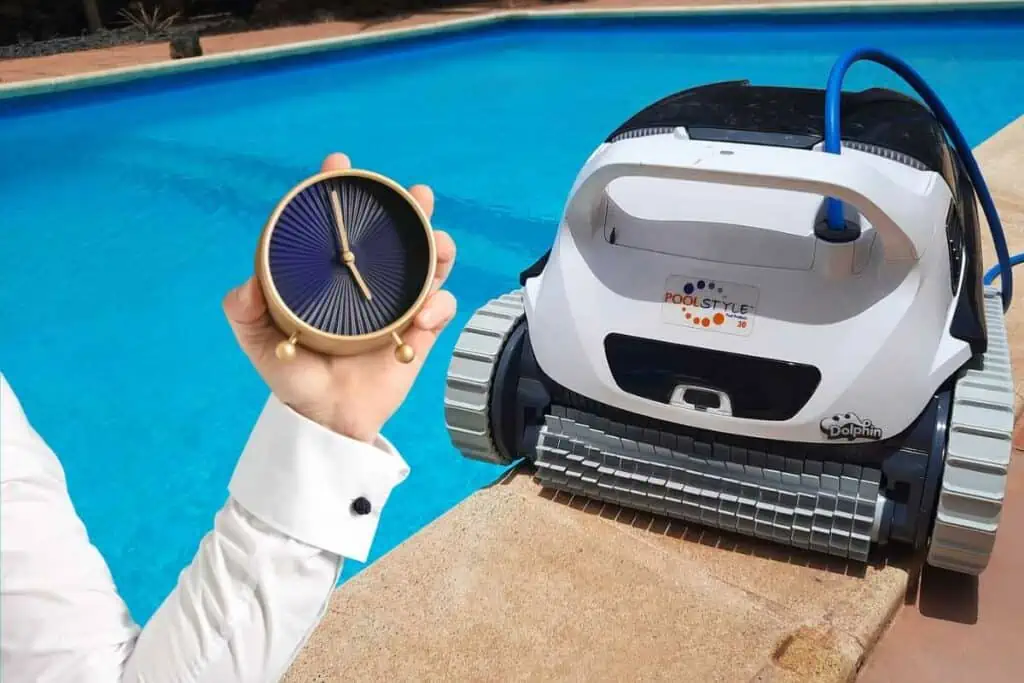Robotic pool cleaners have become increasingly popular in recent years because they efficiently clean pools with minimal effort from the pool owner. However, one question that often arises is how often you use a robotic pool cleaner.
The answer to this question depends on a few factors, such as the size of the pool, the amount of debris that falls into the pool, and the frequency of pool use. Generally, running the robotic pool cleaner at least once a week is recommended to ensure the pool stays clean and debris-free.
However, if the pool is used frequently or if there are many trees or other plants nearby that shed leaves and other debris into the pool, it may be necessary to run the robotic pool cleaner more often. On the other hand, if the pool is not used very often or if minimal debris falls into the pool, it may be possible to run the cleaner less frequently.

Factors that Influence How Often to Run Your Robot
Pool Usage Frequency
The frequency of pool usage is a significant factor to consider when determining how often to run a robotic pool cleaner. If your pool is used all day, every day, mainly by lots of kids, you may be justified in running the cleaner once a day to ensure that the water remains clean and safe for swimming.
However, if your pool is not used as often, you can run the cleaner once every two, three or even seven days.
Pool Size and Shape
The size and shape of your pool also determine how often to run the robotic pool cleaner. Larger pools may require more frequent cleaning to cover all areas.
Additionally, the shape of your pool can impact the efficiency of the cleaning process. Pools with irregular shapes or complex designs may require more frequent cleaning to ensure all areas are properly cleaned.
Type and Amount of Debris
Another factor to consider when determining how often to run your robotic pool cleaner is the type of debris accumulating in your pool.
If your pool is located in an area with many trees, you may need to run the cleaner more frequently to remove leaves and other debris. Similarly, if your pool is near a construction site, you may need to run the cleaner more often to remove dust and other debris.
My pool has several trees nearby, and we also get a type of wind called a Calima quite frequently, which carries dust.
Overall, it is important to consider these factors when determining how often to run your robotic pool cleaner. Doing so can ensure your pool remains clean and safe for swimming without wasting energy or resources.
| Cleaning Frequency | Debris Level | Benefits |
|---|---|---|
| Daily | High | Keeps pool free of debris, prevents algae growth |
| Weekly | Moderate | Removes dirt/dust, prevents algae growth |
| Bi-Weekly | Low | Removes dirt/dust, prevents algae growth |
| Monthly | Very Low | Removes dirt/dust, prevents algae growth |
Manufacturer’s Recommendations
Follow the guidelines provided by your robotic pool cleaner’s manufacturer. They may have specific recommendations based on the model’s features and capabilities.
How long to run your robotic pool cleaner for?

A number of different factors may alter how long you run your robotic cleaner, as well as some of the above factors, such as the amount of debris and how often the pool is used.
These include:
Cleaner Model and Capabilities
Different robotic pool cleaner models offer varying features and capabilities, which can influence the recommended runtime. Some advanced models are designed for quicker, more efficient cleaning, while others may require more time to cover the entire pool surface thoroughly.
The average automatic runtime for a robotic cleaner is around 2 hours, which should be long enough in most situations. If your pool is not completely clean after this time, start it up again.
Always consult your cleaner’s manual for specific recommendations on runtime based on the model and its features.
Pool Size
This is an obvious one. The size of your swimming pool also affects how long you should run your robotic pool cleaner.
Larger pools may necessitate longer cleaning sessions to ensure all surfaces are adequately cleaned. Conversely, smaller pools may require less time to achieve similar results.
When determining the ideal runtime, remember your pool’s dimensions and adjust the cleaning duration accordingly.
Monitoring and Adjusting
It is essential to monitor your pool’s cleanliness regularly and adjust the runtime of your robotic cleaner as needed. Over time, you may find that increasing or decreasing the cleaning duration will provide better results based on your pool’s specific needs and environmental factors.
Summary
In conclusion, there is no one-size-fits-all answer to how often to run a robotic pool cleaner. Consider your pool’s usage, debris levels, cleaner model, and size when determining the ideal cleaning duration. Regularly monitor your pool’s cleanliness and adjust the runtime to maintain a clean, inviting, and healthy swimming environment.





Leave a Reply